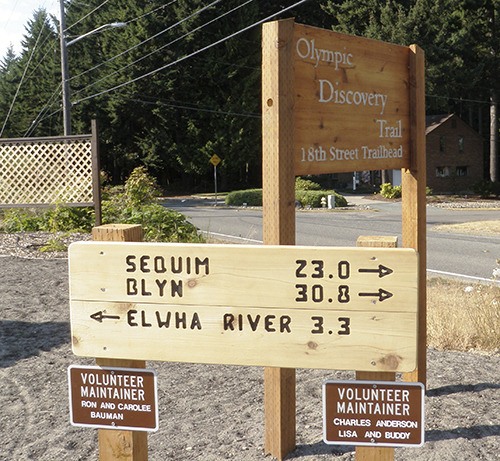Clallam County officials have and continue to be both willing and eager to accommodate the Olympic Discovery Trail.
Although the trail has been a work in progress since the late 1980s, it has yet to be completed for a variety of reasons, but the most challenging of all is “acquiring the rights-of-way” necessary to build the trail, according to Andrew Stevenson, vice president of the Peninsula Trails Coalition.
The projected 128-mile route from Port Townsend to the edge of the Pacific Ocean at La Push goes through 14 jurisdictions, such as city and county lands and property owned by state and national park services.
Planning with so many different jurisdictions can be problematic when trying to construct a shared entity, Stevenson told attendees at the Sequim-Dungeness Valley Chamber of Commerce meeting Tuesday, Aug. 12. He said there are as many as 900 landowners that officials within those jurisdictions will work with or have worked with to gain rights-of-way for the trail’s completion.
Along with general construction, the trail still needs more signage, trail head amenities, restrooms and American with Disabilities Act access, Stevenson said.
If such needs were met with greater marketing and outreach, the trail’s “tremendous unrealized potential as an engine for tourism” could be tapped into, Stevenson said.
It’s a similar message locals heard when the Washington Blue Ribbon Task Force on Parks and Outdoor Recreation created by Gov. Jay Inslee mid-February came to Sequim on Aug. 19.
The task force’s goal, according to state documents, is to “develop an action plan and issue recommendations to manage, transform, better leverage or develop Washington’s outdoor recreation assets and state programs to increase outdoor recreation activities, as well as promote the jobs and businesses associated with outdoor recreation.” To that end, the task force has found that outdoor recreation activities in Washington state directly support 227,000 jobs, consumers spend $22.5 billion on outdoor recreation-related expenditures and in turn generate $1.6 billion in state and local tax revenue were among Inslee’s reasons to create the task force.
A draft report is due to Inslee by Sept. 4.
While in Sequim, the task force compiled 20 public comments from residents, small business owners, state and county officials to outdoor recreation groups. From the comments three themes emerged, including support for recreational fishing, support to eliminate the Discovery Pass and support for the Maritime Tourism Bill, according the meeting summary.
At the meeting, Rich James, transportation program manager for Clallam County Public Works, described how the Olympic Discovery Trail is a successful example of the region’s outdoor recreation outlets and tourism programs.
On the trail
Thus far, it is possible to travel 85 miles by way of the Olympic Discovery Trail throughout Clallam County, James said. Although a portion of the 85 miles isn’t paved near the Spruce Railroad trail along Lake Crescent, county officials are working to have it paved and anticipate completion of that portion by 2018.
“There are both compelling health and economic reasons to support the trail system,” James said. “We’ve got a very unique county because the politicians here have been supportive of the trail and recognize the window of opportunity.”
As one example of the some of the economic opportunities the trail provides, James said that since 2003 the annual North Olympic Discovery Marathon has generated between $500,000 and $1 million. The marathon is just one of 10 public annual events that relies on the trail.
“We’re already seeing enough use and benefits from the trail to justify what we’re putting into it,” James said.
Although Clallam County has been “incredibly supportive” with the pursuit to complete the trail, Stevenson said not all jurisdictions have been as proactive. That is likely because each jurisdiction has its own priorities, Stevenson said; for example, the U.S. Forest Service and Department of Natural Resources are not as “easy of a sell” because those agencies’ priorities are not as heavily focused on recreation.
It was just within the past two years the City of Sequim really began to make progress with the trail’s implementation, Stevenson said.
“We should continue to encourage tourism as an economic driver in Sequim,” said Joe Irvin, special projects manager for City of Sequim. “There (have) been numerous times during public outreach efforts that people have told (city officials) that they travel here to use the trail system. It’s definitely a component of ecotourism.”
The three major gaps within the trail system are located in Jefferson County, near Joyce and the far west end of the trail, Stevenson said. To construct the trail at each “gap” will require cooperation and collaboration from private landowners and large corporate landowners, not to mention working with limited resources and with the topography of the route.
“Each gap has its own challenges,” Stevenson said. “But the trail is moving forward in a lot of places and I refer to these areas as ‘points of light.’”
Since Stevenson became immersed with the Peninsula Trails Coalition in 2007, the trail has averaged growth of about 2 miles per year. With the slow but steady ongoing growth, Stevenson continues to “believe in the promise of great economic potential” and both health and community benefits of a complete rail to trail system.
For more information about the Olympic Discovery Trail, visit www.olympicdiscoverytrail.com. Or, for information on the Washington Blue Ribbon Task Force on Parks and Outdoor Recreation, visit www.rco.wa.gov/boards/TaskForce.shtml.
Reach Alana Linderoth at alinderoth@sequimgazette.com.



